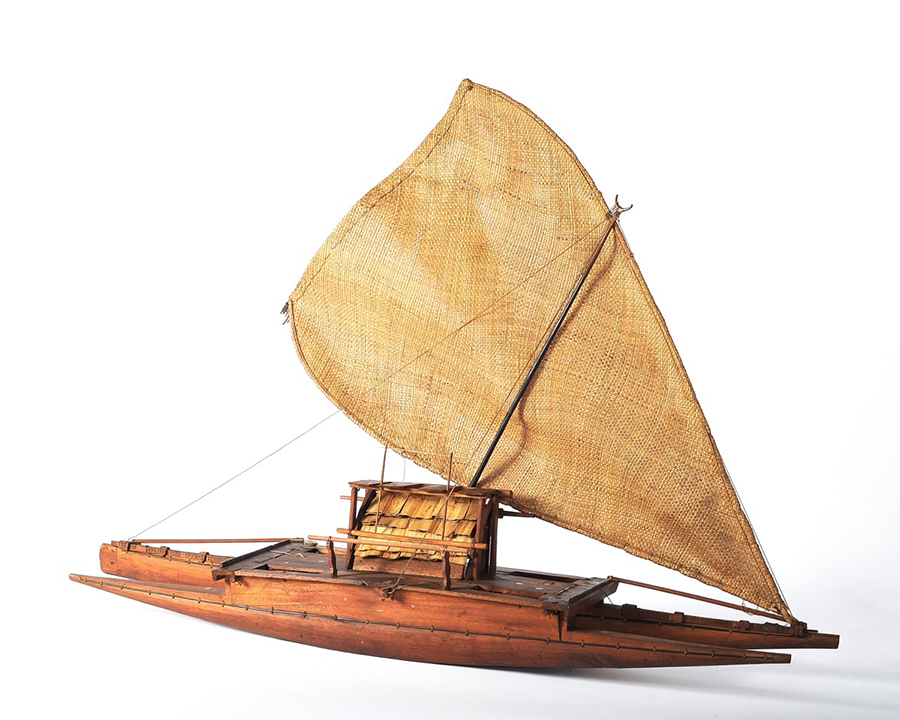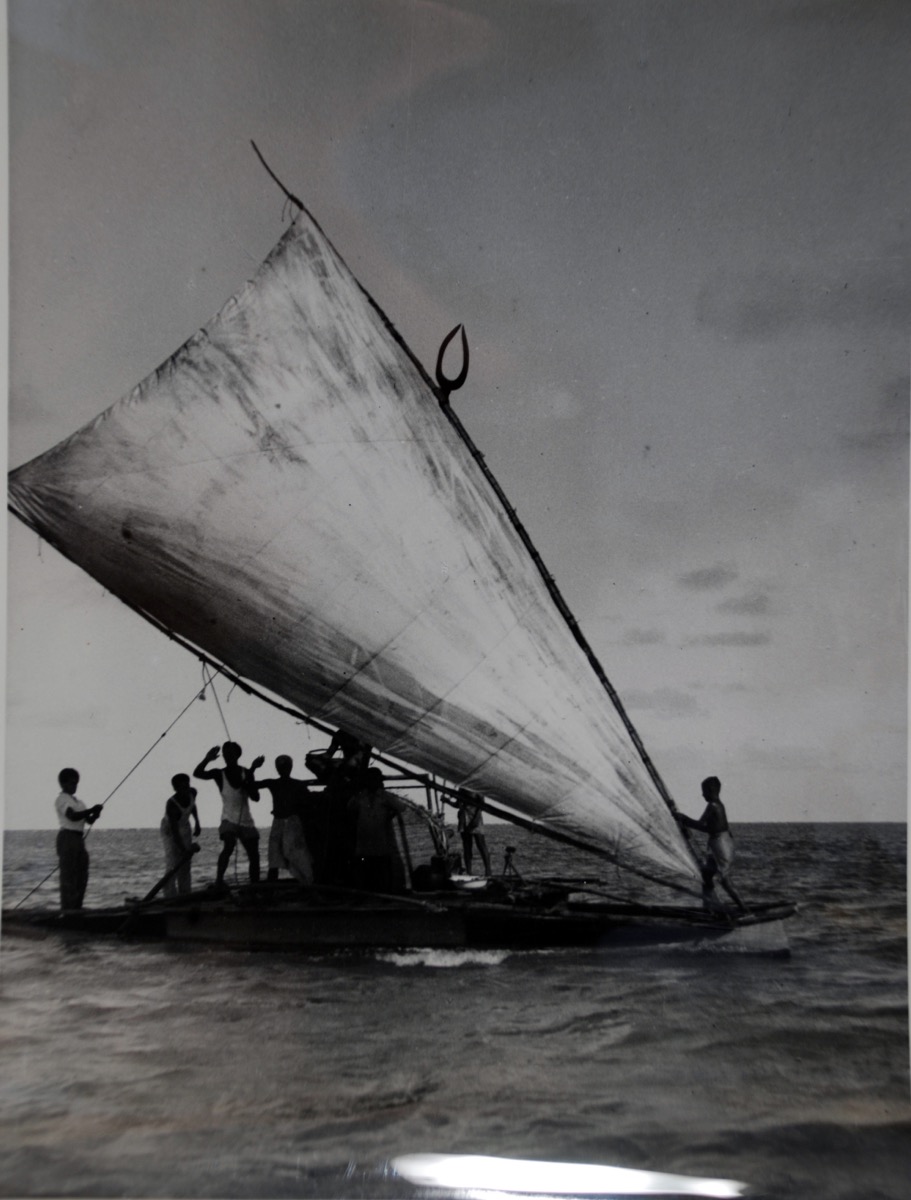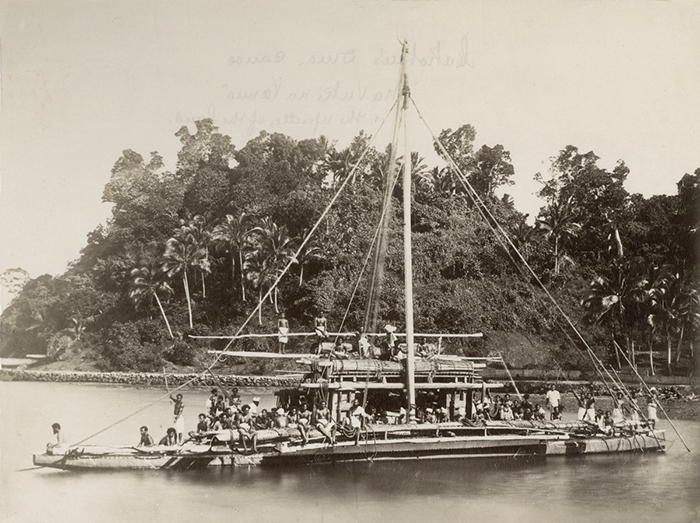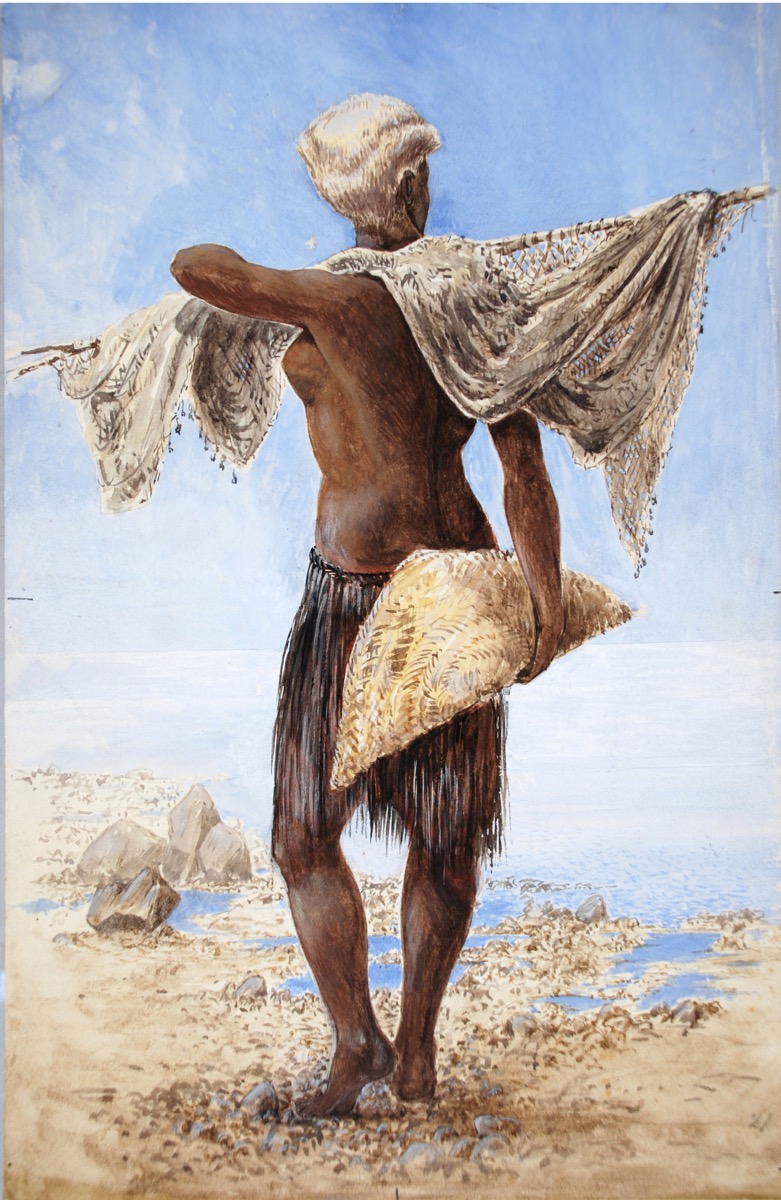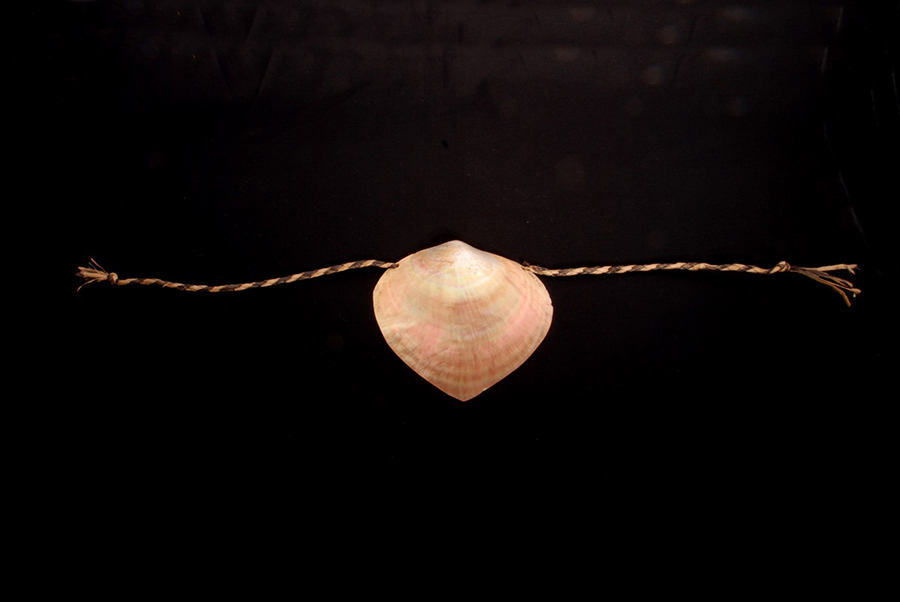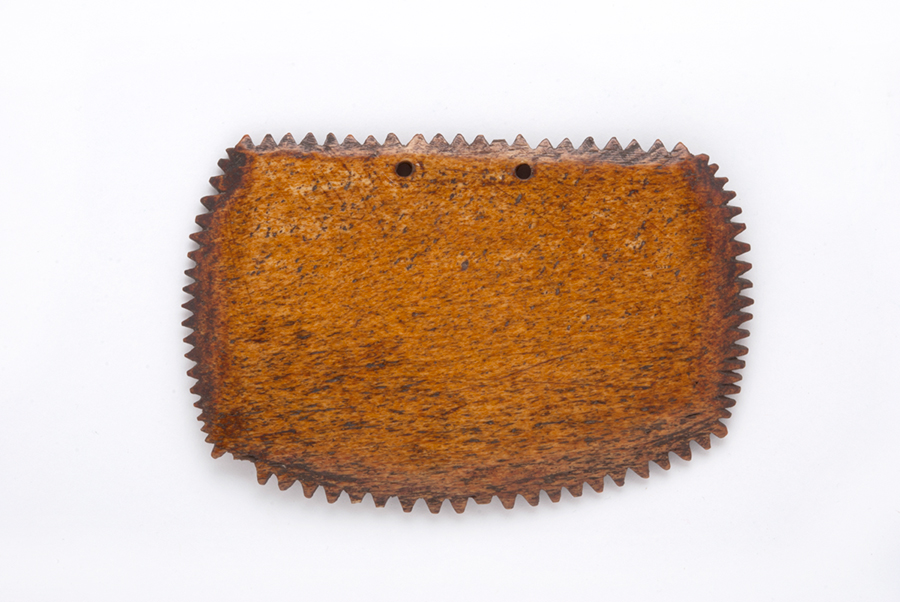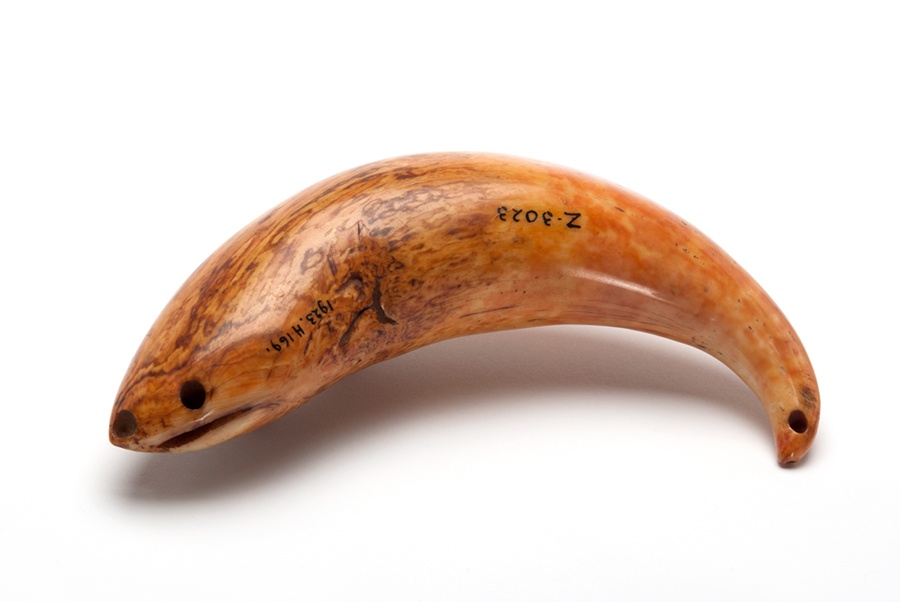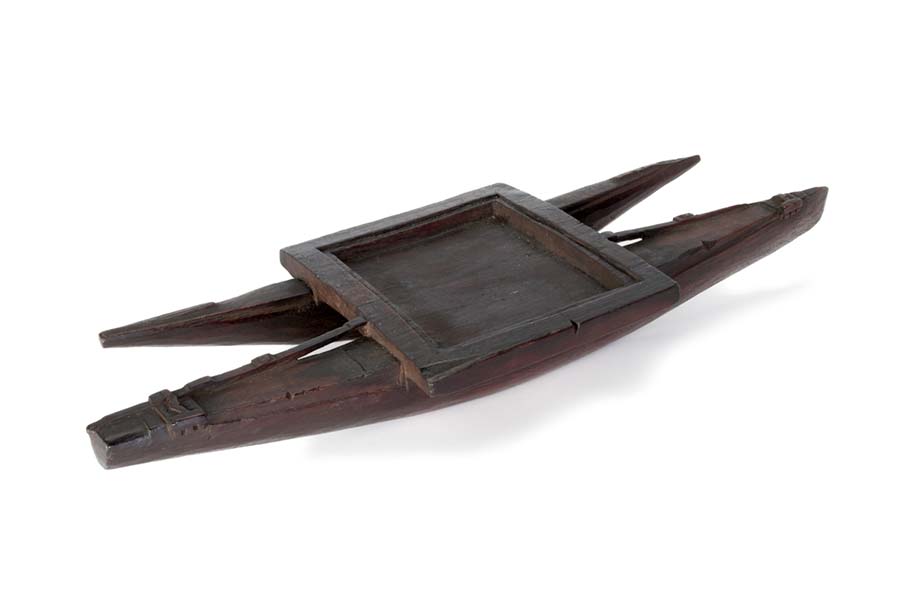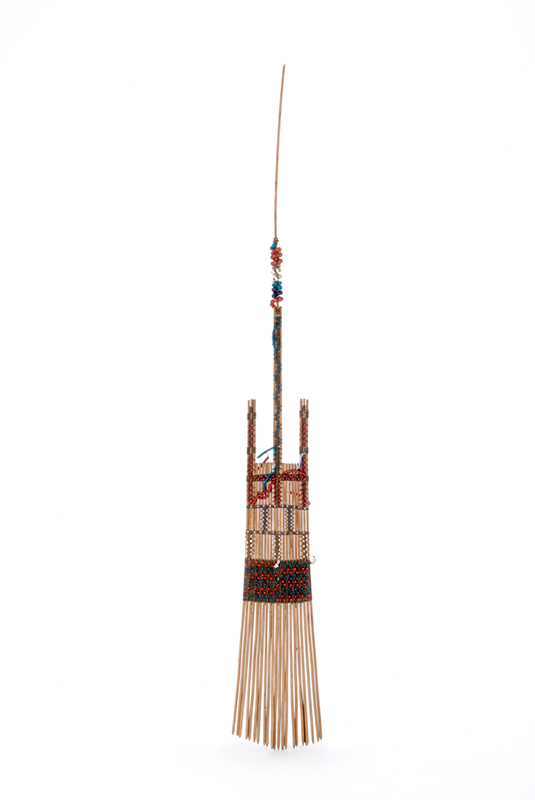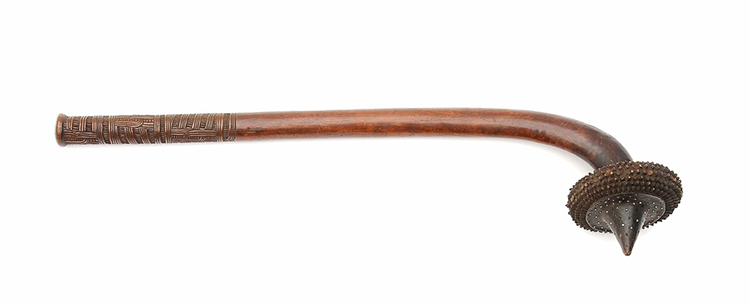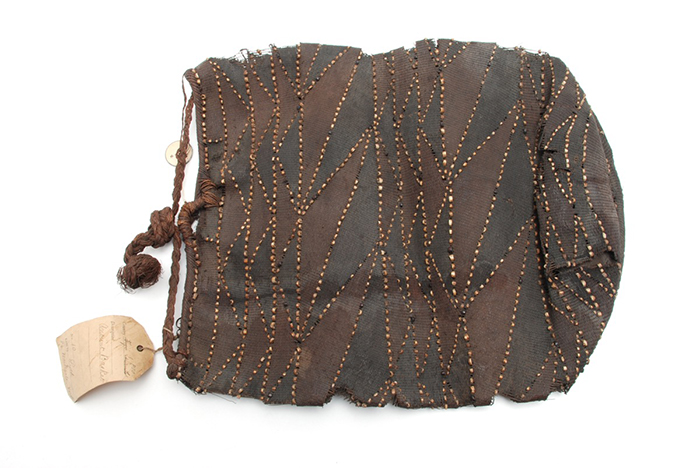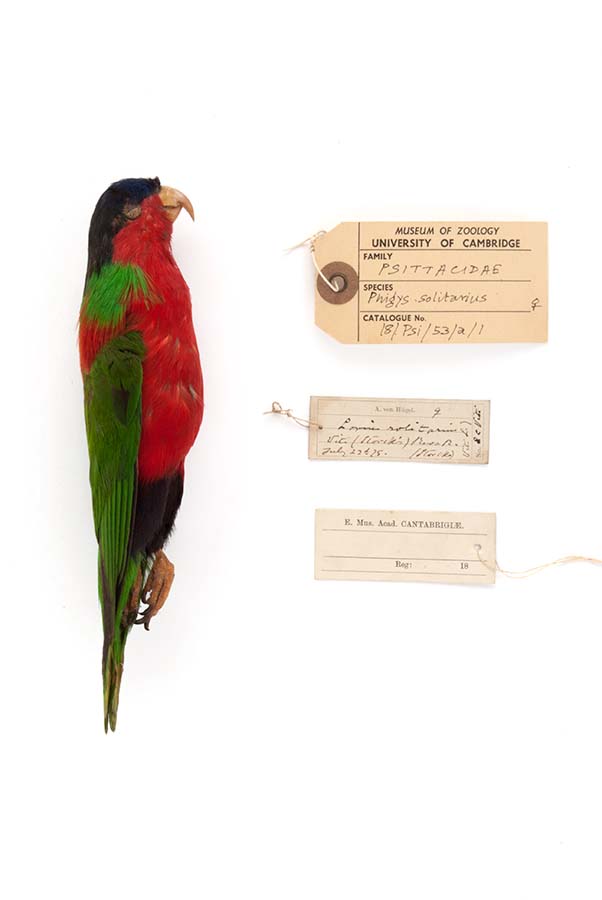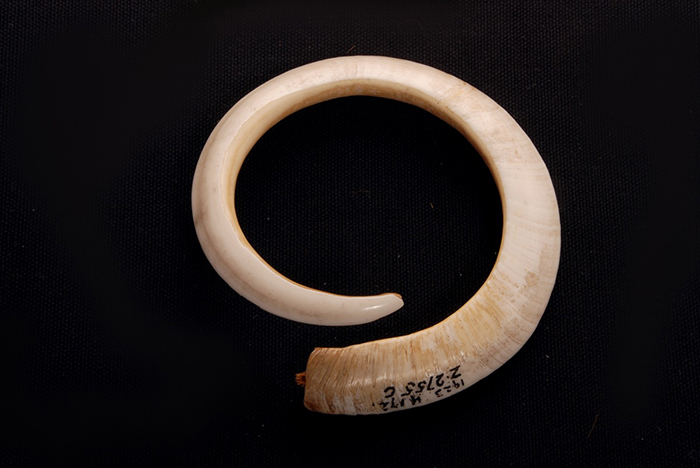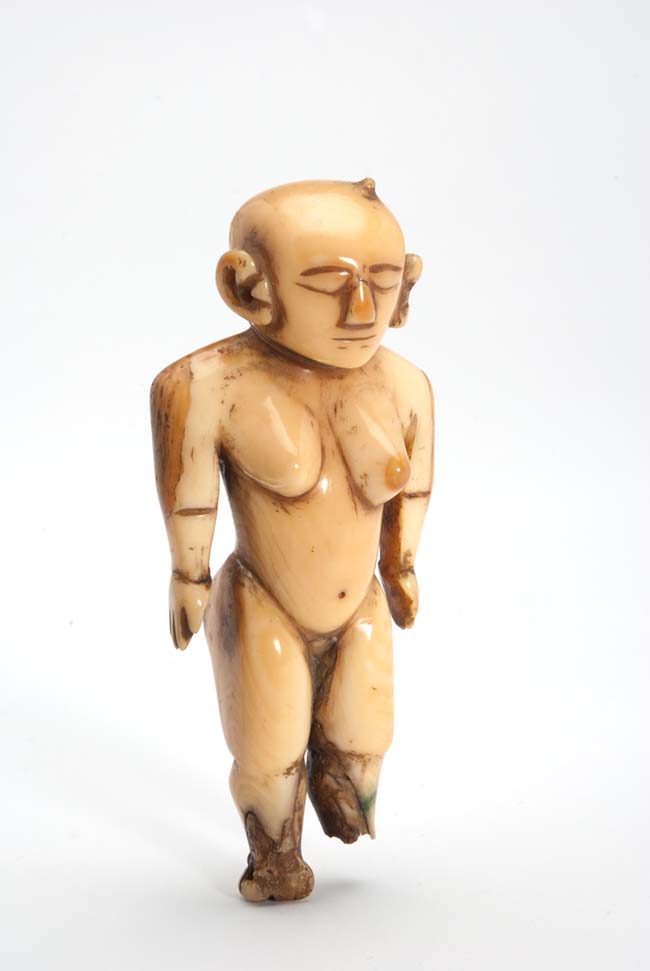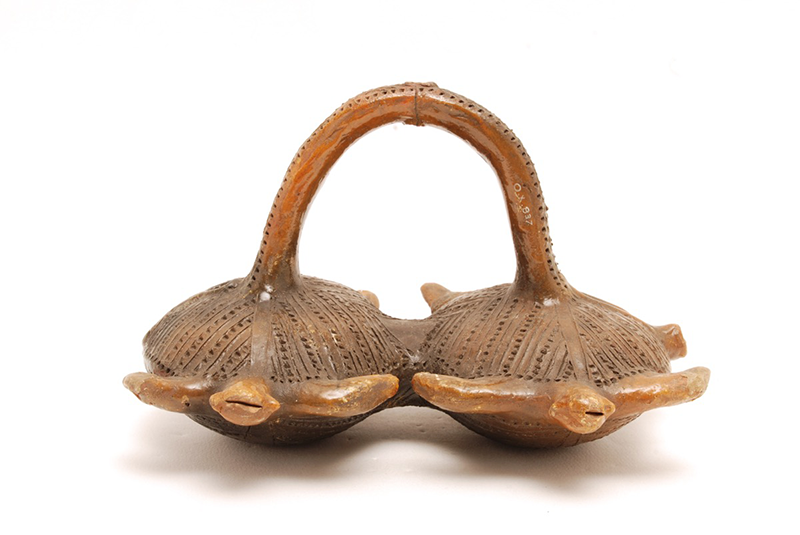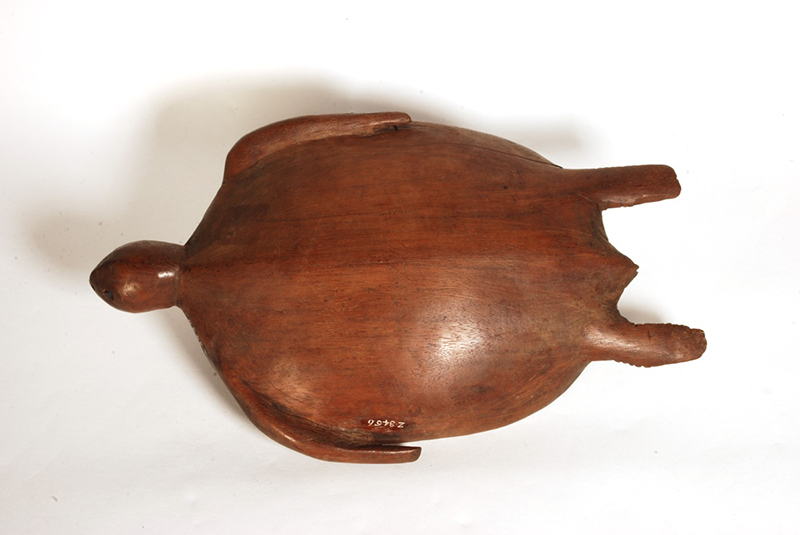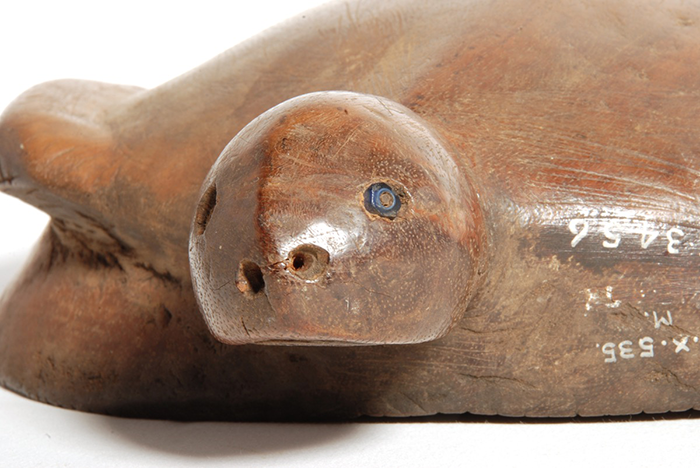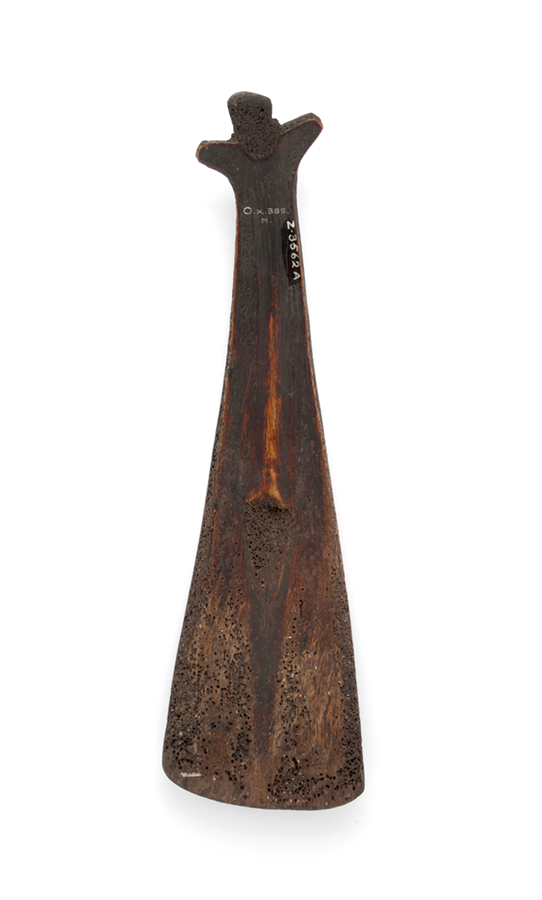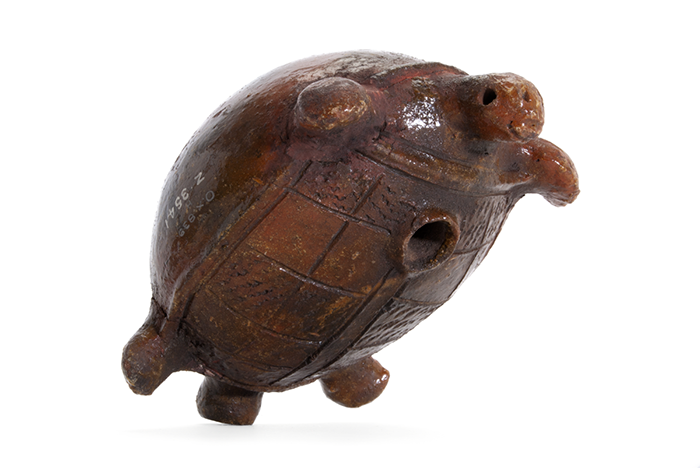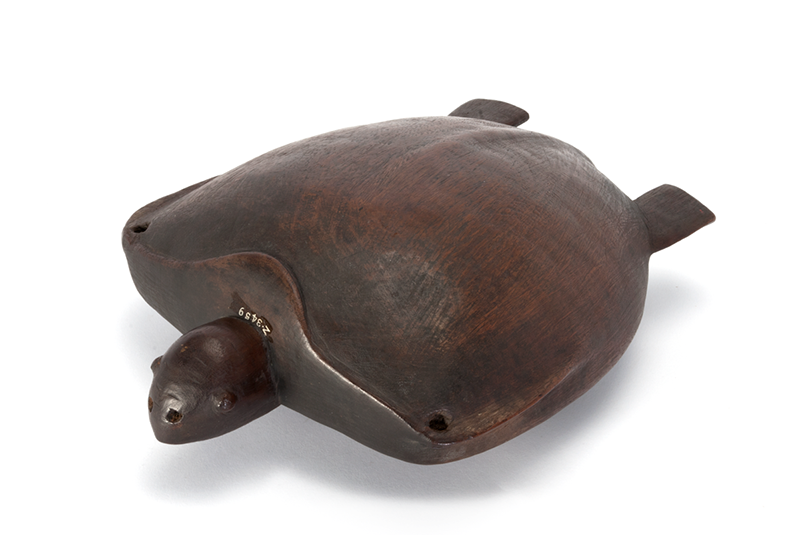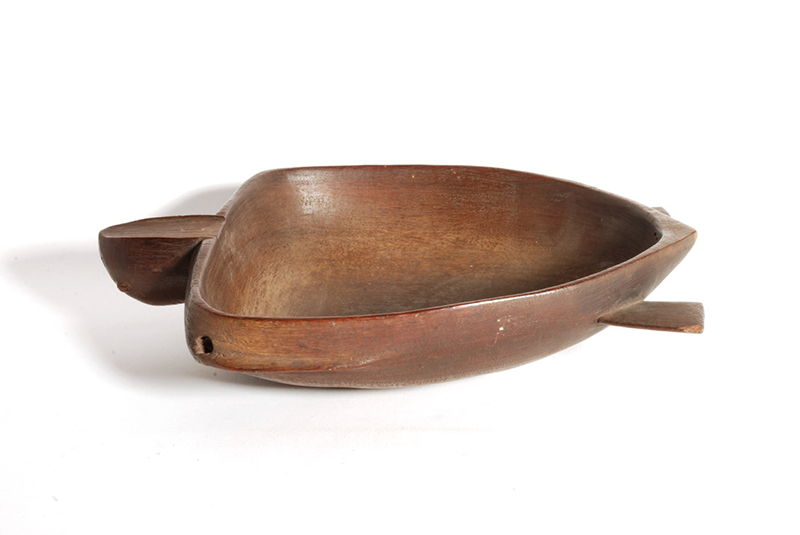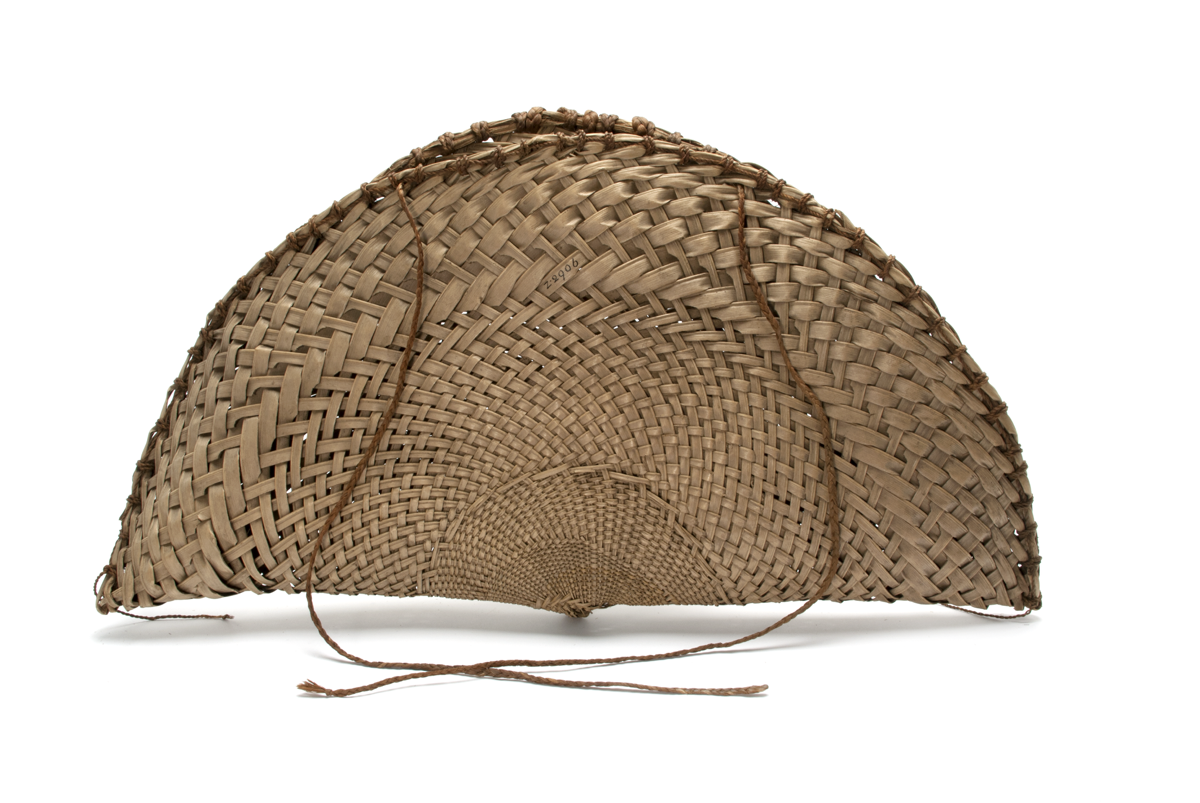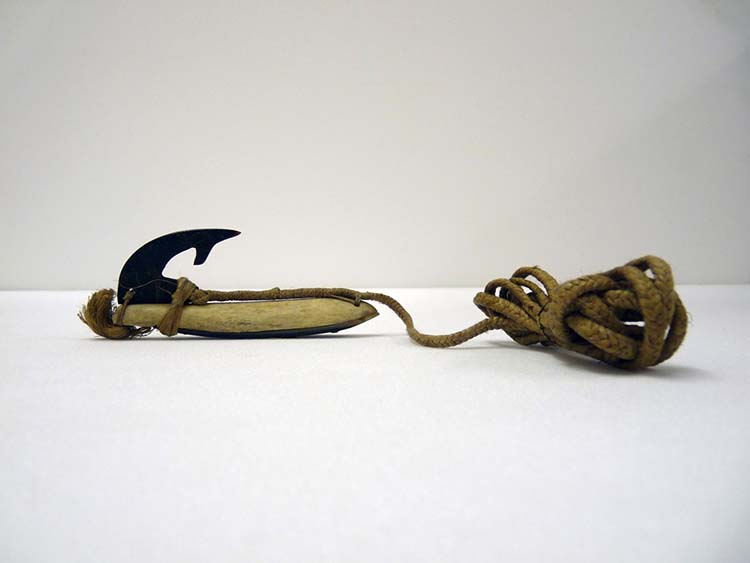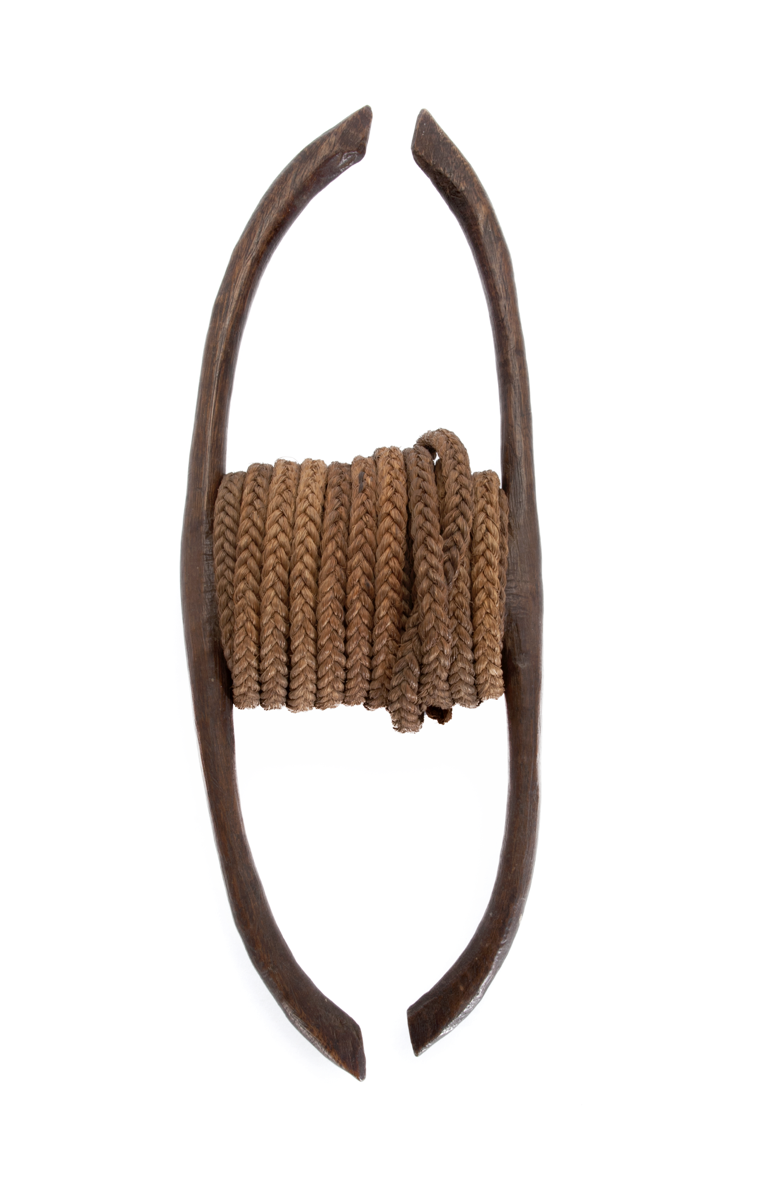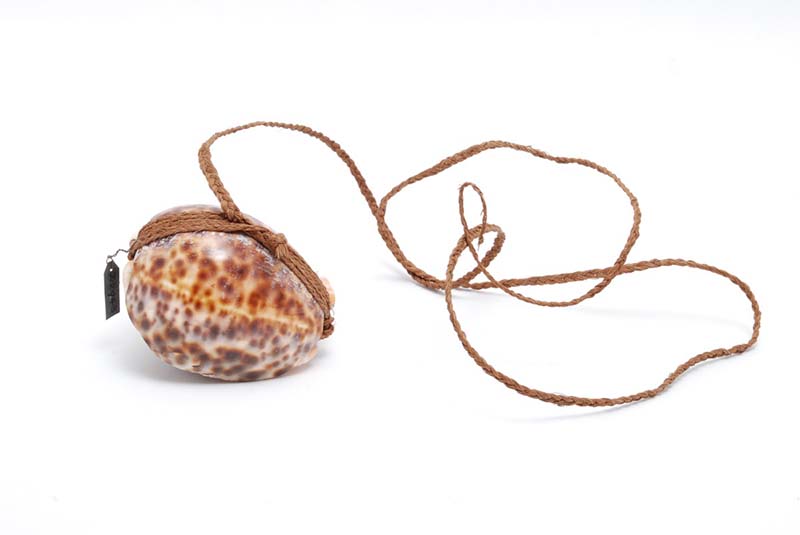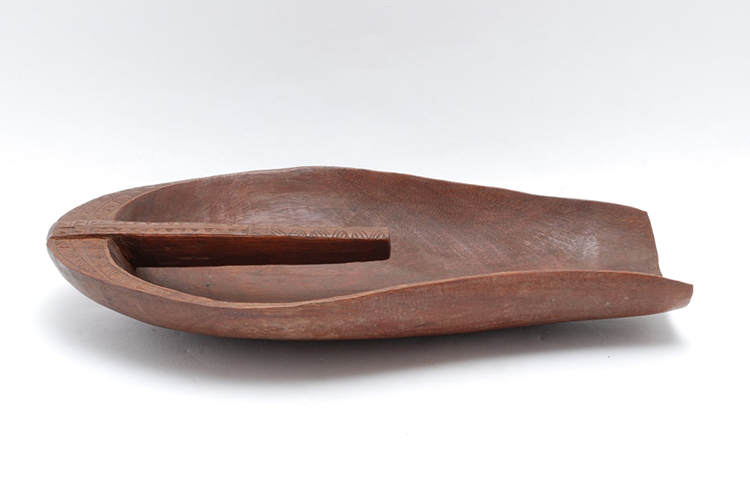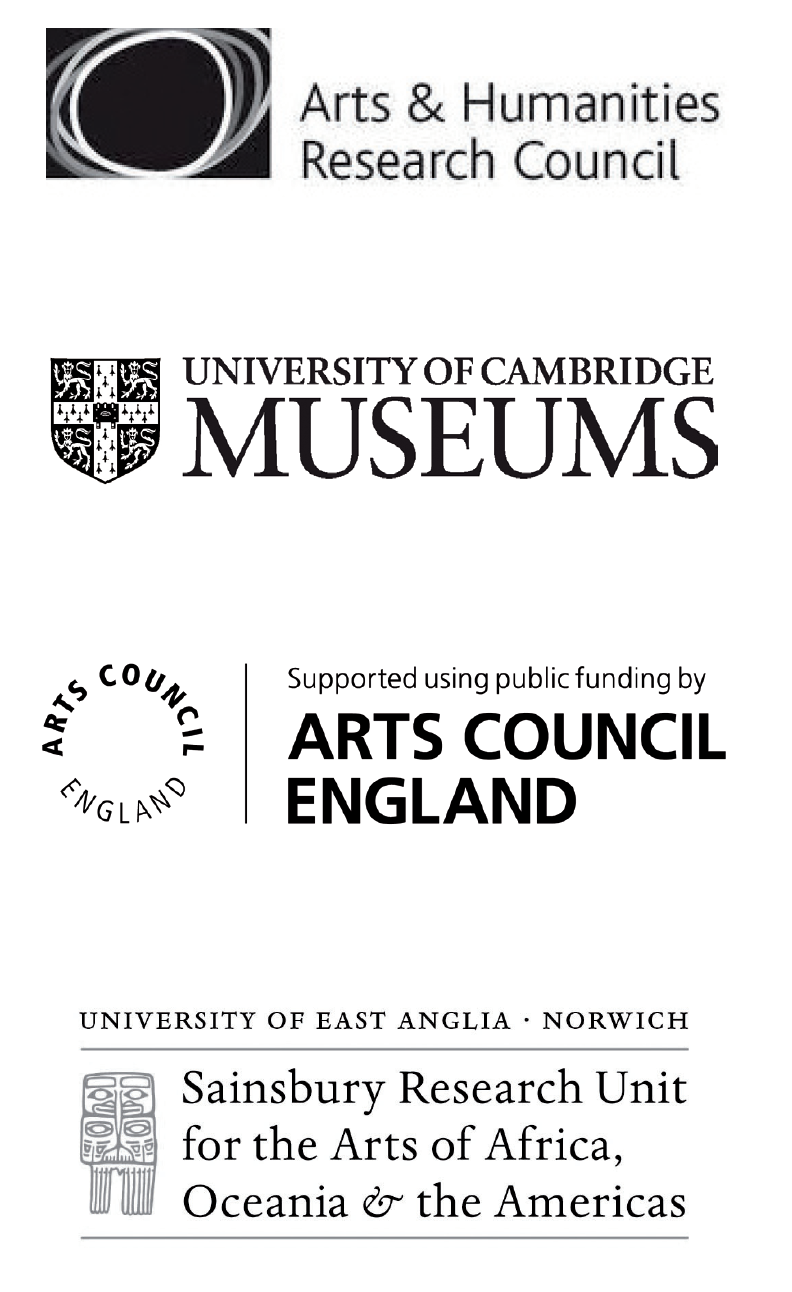Fiji comprises over three hundred islands in the South Pacific. People, places and ideas are linked by the sea. The intermingling of distinctive cultural traditions is demonstrated by the rich material in MAA's collections.
Painting. J. Glen Wilson, 1856. A fleet of drua off the coast of Ovalau Island. By the mid-19th century some drua measured 30 metres in length and were capable of carrying over 100 men. The pennants streaming from the lower yard of the central canoe identify her as the Ramarama, flagship of the Cakobau, the Vunivalu of Bau. Private collection.
Almost 3000 years of voyages and migrations has created a complex settlement picture in Fiji. By the 19th century extensive exchange networks were established between competitive chieftainships throughout Western Polynesia. Double-hulled canoes (drua) travelled long distances throughout the region. Refinements in their design are indicative of the movement of specialist knowledge and skills.
Samoan and Tongan canoebuilders settled in the coastal regions of eastern Fiji, where they worked in the service of local chiefs. Their skills were adapted to the production of highly valued regalia fasioned from the teeth of the sperm whale (Physeter catodon or macrocephalus).
Materials originating from the sea carried high status. Tabua, a presentation whale's tooth attached to a fibrous cord, continue to be the most important of all Fijian valuables. They mark political alliances and are gifted on occasions such as births, death and the settlement of grievances.
Use the drop down menu below to explore the themes and objects in this section.
Drua travelled long distances through Western Polynesia. During the early/mid 19th century, some of these measured over 30 metres in length and were capable of carrying well over 100 men. Refinements in the design and construction of these remarkable vessels incorporated specialist knowledge and skills developed throughout the Pacific region. The Fijian feature of having unequally sized hulls facilitated handling. Hulls were constructed of logs, bored and fitted with ribs and lashed together with coir binding.
The method of planking was introduced into the Lau region of Fiji in the second half of the 18th century by canoe-builders of Samoan origin. Performance was grealty improved by the adaptation of Micronesian rigging and a flexible sail plan, whereby the canoe became amphidromous and could move forward in either direction. A house and platform, typically reserved for chiefs and their retinue, was centrally positioned on top of the deck.
Model Drua
Double-hulled canoe with plaited pandanus sail and crescent-shaped mast head (domodomo). This model does not feature the planking found on large-scale drua.
Probably Viti Levu, Fiji. Collected by A. von Hügel, 1875-77. Z 2706
Photograph: Double-hulled canoe, Drua
A small drua about to cavu, which involves lifting the sail from one end of the main hull, sliding it along to slot into the other end, thereby changing direction. Small double canoes continued to be made into the second half of the 20th century.
Photographed by Father J.B. Neyret, 1931-35
Fiji. Collected by J. Hornell. P. 43887.HNL
Photograph: Nanukinivanua
Nasova, Ovalau Island, Fiji. Presented to Lady Gordon by Cakobau, 20 November 1877. P.99803.VH
One of the last great drua, named Navukinivanua (the turner of the land), probably in reference to the shift to colonial rule. Over 30 metres in length it has more than 100 people on board, including members of Cakobau’s family and his retainers. Its presentation by Cakobau to Lady Gordon did not indicate the transfer of exclusive ownership but was intended as a means of promoting ongoing relationships.
Cakobau landed, and Rachael [Lady Gordon], accompanied by Wilkinson, met him at the door of the dining-room and accepted the symbolic whale’s teeth. Then she offered her whales tooth, and begged him to “take care of the canoe for her, and use it.” He accepted the symbol, and she then sent a present of cloth, etc., on board for the crew.
- Sir Arthur Gordon’s notes, November 1877.
Woman carrying a net and basket
This drawing was probably made by Arthur J.L. Gordon, Private Secretary to Sir Arthur Gordon, the first Governor of Fiji. It depicts a young Fijian woman carrying a net (lawavakaicua) and a fishing basket (noke).
Materials originating from the sea figure prominently as markers of status as well as in ceremonial exchanges. The teeth of the sperm whale (Physeter catodon or macrocephalus) continue to be of particular value. Fish and fishing remain very important in the diet and culture of Fijians, especially in coastal regions.
Shell breastplate, Civa
Polished shell, probably gold-lipped oyster (Pinctada maxima) strung on two lengths of twisted pandanus fibre. Shell breastplates like this probably preceded whale ivory ones.
Fiji. Collected by Sir A. Gordon, 1875-80. Z 2724
Necklace, Sisi
Whale teeth necklaces were important exchange items. Fijians did not hunt whales so supplies were limited to occasional beached whales and trade with Tongans and Europeans.
Viti Levu, Fiji. Collected by A. von Hügel, 1875-77. Z 2725
Breastplate
Carved plate of whale bone with serrated edges. This breastplate was repeatedly rubbed with coconut oil and smoked, resulting in the rich dark colour particularly visible at the back.
Levuka, Fiji. Acquired by A. von Hügel from the 'Cheat', 27 October 1875. Z 2747
Presentation whale tooth, Tabua
Tabua are regarded as the most important of all Fijian valuables. The unusual curve of this tooth is reminscent of a shark.
Fiji. Collected by A. von Hügel, 1875-77. Z 3023
Priest's dish
Wood carved in the form of a double-hulled canoe. This dish was used by priests to hold scented coconut oil (waiwai) with which they anointed themselves.
Rewa River, Viti Levu, Fiji. Collected by A. von Hügel, 1875-77. Z 3799
There is a long history of exchange within Western Polynesia, motivated and maintained by complex social relations that developed between groups in Fiji, Tonga and Samoa. Pacific Islander visitors to Fiji brought distinctive objects, materials, skills, practices and beliefs.
Hair comb, Seru
Made of the midribs of the coconut leaf (sasa) and decorated with coloured glass beads. Combs like this reveal both Samoan and Tongan stylistic influences.
Fiji. Collected by A. von Hügel, 1875-77. Z 2801
Club, Totokia
The head is inlaid with tiny glass trade beads. The handle is decorated with Maori-style patterns, probably carved by a Maori who came to Fiji as a crew member on a bêche-de-mar trading ship.
Originally from Fiji. Acquired by L. Clarke from S. Woolston, date unknown. 2013.13
Bag
Tongan-style bag of finely woven red and black palm spathe with coir around the mouth and handle. It is decorated with white shell beads.
Fiji. Collected by Rev. R.B. Lyth, c.1840s. Deposited by the Methodist Missionary Society. D.1957.4
Kula bird (Phigys solitarius)
In the 18th century, there was a great demand in Tonga for the red feathers of the Fijian kula bird. Taken to Samoa, they adorned finely woven kilts ('ie tonga) that were prized by Tongan and Fijian chiefs.
Rewa River, Viti Levu, Fiji. Collected by A. von Hügel, 22 July 1875. Cambridge University Museum of Zoology, 18/Psi/53/a/1
Boar's tusk pendant, Batinivuaka
Circular boar's tusks were probably traded from New Caledonia and Vanuatu. They were highly valued in Fiji and worn by chiefs at the base of the throat.
Fiji. Collected by Sir A. Gordon, 1875-80. Z 2755 C
Whale ivory figure
Ivory figures, originating in Tonga or produced by Tongans in Fiji, were venurated as ancestor gods and kept in the shrines of Fijian spirit houses. Captain Cook collected a similar example in Tonga in teh 1770s.
Probably from Tonga. Acquired by L.Clarke from H.Beck, 1925. 1925.336
Turtles were central to many spiritual and social practices, featuring prominently in feasts associated with large gatherings. Rights to catch and consume turtles were determined by hereditary privileges and links with ancestral spirits. Turtle shell was considered a valuable material but was usually traded with Tonga rather than incorporated into Fijian objects.
Water pot, Saqa
Earthenware water pot formed of two turtles connected at the side. Originally a cord of plaited coir would have been inserted through the hole at the top of the handle to suspend the pot.
Fiji. Collected by A. von Hügel, 1875-77. Z 3543
Yaqona bowl, Darivonu
Shallow wooden bowl for yaqona in the shape of a turtle. The old blue glass bead inlaid in one of the eyes of the turtle suggests that this was a high-status object.
Fiji. Collected by A. Maudslay, 1875-77. Z 3456
Spatula, iSuvisuvi
Spatula made of turtle bone used to cut fruits and vegetables.
Fiji. Collected by A. Maudslay, 1875-80. Z 3562 A
Water pot, Saqa
Earthenware water pot in the shape of a turtle. At the top, the surface is incised with grooves and imprinted with the edge of a bivalve shell, evoking the texture and patterns of turtle shell.
Fiji. Collected by A. von Hügel, 1875-77. Z 3541
Yaqona bowl, Darivonu
Wooden bowl for yaqona in the shape of a turtle. The very naturalistic rendering of the spine gives the look and feel of a turtle's shell, contrasting with the more schematic treatment of the head and limbs.
Possibly Viti Levu, Fiji. Collected by A. von Hügel, 1875-77. Z 3459
An impressive variety of fishing equipment was used in Fiji, reflecting the diversity of fishing grounds: inside and outside reefs as well as rivers. While some of these objects are unique to Fiji, other technologies were borrowed from neighbouring islands in Western Polynesia.
Fishing basket, Noke
Formed of a woven disk of coconut leaf folded in two. It is laced along the sides, leaving a small opening at the top through which the fish can be dropped. They are used by the women and worn on the hip.
Fiji. Collected by A. von Hügel, 1875-77. Z 2906
Fishhook, Siwa
Siwa is the only type of indigenous Fijian hook known. Made of mangrove wood (tiri), these hooks were often used with a stone sinker to catch sharks and large fish outside the reef.
Navuavua, Rakiraki, Viti Levu, Fiji. Collected by A. von Hügel, 1875-77. Z 2912
Fishhook, Bayaloyalo
Hook of whale bone, pearl shell,turtle shell and vegetable fibre of Tongan manufacture. Hooks like this do not need bait as the fibre hackle and pearl shell act as a lure. They were prized as prestigious chiefly exchange items.
Tonga. Possibly collected by Rev. Daniel Wheeler, 1830s. Z 5963
Netting needle, Sika
Large needles used by Fijian women to make nets of yaka fibre (Pueraria lobata) for catching turtles. A length of finely plaited coir cord is wound around the central bar.
Navuavua, Rakiraki, Viti Levu, Fiji. Collected by A. von Hügel, 1875-77. Z 2923 A
Octopus lure
Lure formed of two pieces of tiger cowrie shell (Cypraea tigris) enclosing a heavy coral sinker and decorated with small olive shells (Oliva carneola). Lures like this one probably originated in Western Polynesia.
Probably originally from Tonga. Collected by Sir A. Gordon,1875-80. Z 2943
Bailer
Canoe bailers such as this were used on small outrigger canoes. The rim of this example is incised with geometrical patterns.



